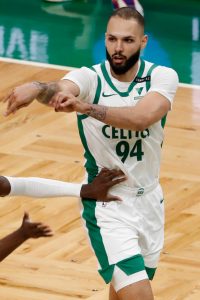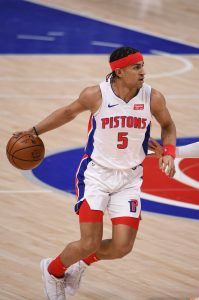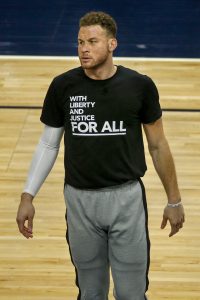The Bird exception, named after Larry Bird, is a rule included in the NBA’s Collective Bargaining Agreement that allows teams to go over the salary cap to re-sign their own players. A player who qualifies for the Bird exception, formally referred to as a Qualifying Veteran Free Agent, is said to have “Bird rights.”
The most basic way for a player to earn Bird rights is to play for the same team for at least three seasons, either on a long-term deal or on separate one- or two-year contracts. Still, there are other criteria. A player retains his Bird rights in the following scenarios:
 He changes teams via trade. For instance, the Celtics will hold Evan Fournier‘s Bird rights when he reaches free agency this offseason, despite just acquiring him in March. His Bird clock didn’t reset when he was traded from Orlando to Boston.
He changes teams via trade. For instance, the Celtics will hold Evan Fournier‘s Bird rights when he reaches free agency this offseason, despite just acquiring him in March. His Bird clock didn’t reset when he was traded from Orlando to Boston.- He finishes a third season with a team after having only signed for a partial season with the club in the first year. The Heat signed Kendrick Nunn and Duncan Robinson during the final week of the 2018/19 season. When their contracts expire during the 2021 offseason, they’ll have full Bird rights because those few days they spent with Miami at the end of ’18/19 started their respective Bird clocks.
- He signed for a full season in year one or two but the team waived him, he cleared waivers, and didn’t sign with another team before re-signing with the club and remaining under contract through a third season. This one’s a little confusing, but let’s use Glenn Robinson III as an example. Partway through his one-year contract with the Kings this season, Robinson was waived. He has yet to join a new team. If the Kings were to re-sign Robinson to a two-year contract in the offseason, without him joining a new team in the interim, they’d have his full Bird rights at the end of that deal.
A player sees the clock on his Bird rights reset to zero in the following scenarios:
- He changes teams via free agency.
- He is waived and is not claimed on waivers (except as in scenario No. 3 above).
- His rights are renounced by his team. However, his Bird clock picks up where it left off if he re-signs with that team without having signed with another NBA team. For example, Bismack Biyombo had full Bird rights last offseason, then had those rights renounced by the Hornets as the team attempted to gain extra cap room. Since Biyombo eventually signed a new one-year deal with Charlotte, he’ll regain his full Bird rights this summer — that wouldn’t have been the case if he had signed with a new team.
- He is selected in an expansion draft.
If a player who would have been in line for Bird rights at the end of the season is waived and claimed off waivers, he would retain only Early Bird rights. Meanwhile, a player with Bird rights who re-signs with his previous team on a one-year contract (or a one-year deal with a second-year option) would lose his Bird rights if he’s traded. As such, he receives the ability to veto trades so he can avoid that scenario.
[RELATED: Players with the ability to veto trades in 2020/21]
When a player earns Bird rights, he’s eligible to re-sign with his team for up to five years and for any price up to his maximum salary (with 8% annual raises) when he becomes a free agent, regardless of how much cap room the team has. The maximum salary varies from player to player depending on how long he has been in the league, but regardless of the precise amount, a team can exceed the salary cap to complete the deal.
A team with a Bird free agent is assigned a “free agent amount” or cap hold worth either 190% of his previous salary (for a player with a below-average salary) or 150% of his previous salary (for an above-average salary), up to the maximum salary amount. For players coming off rookie scale contracts, the amounts of those cap holds are 300% and 250%, respectively.
The Hawks, for instance, will have a cap hold worth $12,411,906 for John Collins on their 2021/22 books — 300% of his $4,137,302 salary for ’20/21. Atlanta could renounce Collins and generate an extra $12MM+ in cap flexibility, but the Hawks would then lose the ability to re-sign him using Bird rights, which would force them to use either cap room or a different cap exception to re-sign him. As such, it’s a safe bet that Atlanta will keep Collins’ cap hold on its books until his free agency is resolved.
Ultimately, the Bird exception was designed to allow teams to keep their best players. The CBA ensures that teams are always able to re-sign them to contracts up to the maximum salary, assuming the player is interested in returning and his team is willing to go over the cap.
Note: This is a Hoops Rumors Glossary entry. Our glossary posts will explain specific rules relating to trades, free agency, or other aspects of the NBA’s Collective Bargaining Agreement. Larry Coon’s Salary Cap FAQ and salary information from Basketball Insiders was used in the creation of this post.
Earlier versions of this post were published in previous years by Luke Adams and Chuck Myron. Photo courtesy of USA Today Sports Images.

 Blake Griffin
Blake Griffin In some cases, teams are carrying cap hits for players whom they released several years ago. That’s the case in Indiana, for instance, where the Pacers have a $2,245,400 cap charge for
In some cases, teams are carrying cap hits for players whom they released several years ago. That’s the case in Indiana, for instance, where the Pacers have a $2,245,400 cap charge for